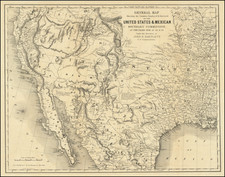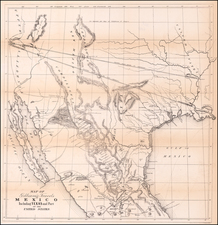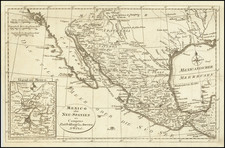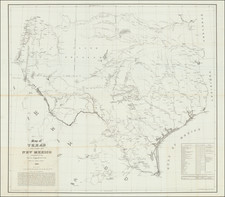Rare geological map of part of West Texas showing parts of Brewster, Presidio, Jeff. Davis, and El Paso counties south of the Southern Pacific Railroad. It was created by Benjamin F. Hill and J.A. Udden for The University of Texas Mineral Survey, directed by William B. Phillips, in 1904.
The map is based on the U.S. Geological Survey (USGS) Topographic Sheets and Reconnaissance Maps covering the area. Fieldwork was conducted by Wm. B. Phillips, B.F. Hill, and J.A. Udden. The map highlights various geological features and resources, such as quicksilver, coal, and silver and lead deposits. The legend provides symbols for each of these features, as well as different rock formations, dikes, and sills.
In addition, the map notes specific geological formations, such as Late Upper Cretaceous sediments containing coal deposits and the areas where quicksilver deposits are found in relation to Upper and Lower Cretaceous formations. Elevations in feet above sea level are also included for various localities.
In the first years of the 20th century, the oil industry in West Texas was still in its infancy. The discovery of oil in Spindletop in 1901, located in East Texas, ignited the Texas oil boom, leading to increased exploration across the state. However, significant oil discoveries in West Texas were yet to be made. The Permian Basin, which spans parts of West Texas and southeastern New Mexico, would later become one of the most important oil-producing regions in the United States, but its vast resources were not discovered until the 1920s.
The map's detailed design and use of symbols and colors provide a comprehensive view of the geological landscape of West Texas during the early 20th century. It serves as an important historical document for understanding the region's geology and the distribution of various mineral resources at that time. The map was printed by The Matthews-Northrup Works in Buffalo, New York.












![(Van Zandt County, Texas) [Preemption Land Grant, signed by Elisha M. Pease,1857 - Texas Land Grant on Kickapoo Creek in Nacogdoches District, Van Zandt County] Preemption. In the Name of the State of Texas](https://storage.googleapis.com/raremaps/img/small/92651.jpg)



![Texas [Arkansas on verso]](https://storage.googleapis.com/raremaps/img/small/99448.jpg)